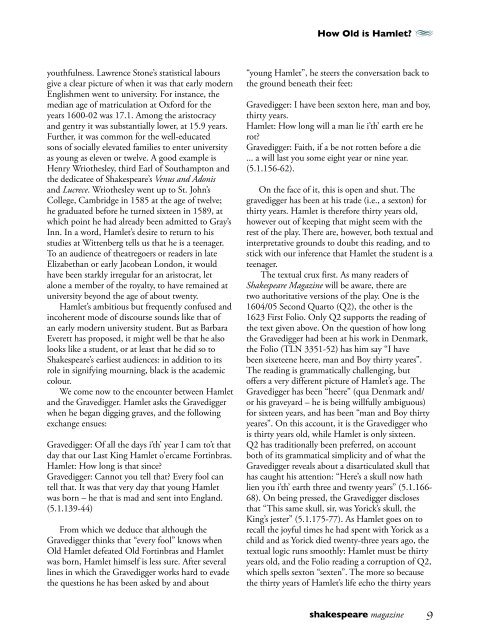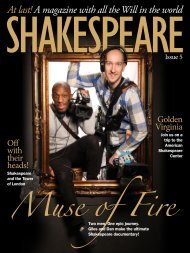Shakespeare Magazine 14
Hamlet is the theme of Shakespeare Magazine Issue 14, with each and every article devoted to the fictional Prince of Denmark and the play that bears his name. Rhodri Lewis asks “How Old is Hamlet?” while Samira Ahmed wonders “Why do Women Love Hamlet?” and we review recent productions of the play starring Tom Hiddleston and Andrew Scott. There's a set report from the making of Daisy Ridley's Ophelia movie and a visit to Hamlet's historic home, Kronborg Castle. We also delve deep into the Victorian Illustrated Shakespeare Archive's Hamlet collection, while Gyles Brandreth tells us about his family production of the play, and Alice Barclay recounts how she taught a group of amateur actors to become Hamlet.
Hamlet is the theme of Shakespeare Magazine Issue 14, with each and every article devoted to the fictional Prince of Denmark and the play that bears his name. Rhodri Lewis asks “How Old is Hamlet?” while Samira Ahmed wonders “Why do Women Love Hamlet?” and we review recent productions of the play starring Tom Hiddleston and Andrew Scott. There's a set report from the making of Daisy Ridley's Ophelia movie and a visit to Hamlet's historic home, Kronborg Castle. We also delve deep into the Victorian Illustrated Shakespeare Archive's Hamlet collection, while Gyles Brandreth tells us about his family production of the play, and Alice Barclay recounts how she taught a group of amateur actors to become Hamlet.
You also want an ePaper? Increase the reach of your titles
YUMPU automatically turns print PDFs into web optimized ePapers that Google loves.
How Old is Hamlet? <br />
youthfulness. Lawrence Stone’s statistical labours<br />
give a clear picture of when it was that early modern<br />
Englishmen went to university. For instance, the<br />
median age of matriculation at Oxford for the<br />
years 1600-02 was 17.1. Among the aristocracy<br />
and gentry it was substantially lower, at 15.9 years.<br />
Further, it was common for the well-educated<br />
sons of socially elevated families to enter university<br />
as young as eleven or twelve. A good example is<br />
Henry Wriothesley, third Earl of Southampton and<br />
the dedicatee of <strong>Shakespeare</strong>’s Venus and Adonis<br />
and Lucrece. Wriothesley went up to St. John’s<br />
College, Cambridge in 1585 at the age of twelve;<br />
he graduated before he turned sixteen in 1589, at<br />
which point he had already been admitted to Gray’s<br />
Inn. In a word, Hamlet’s desire to return to his<br />
studies at Wittenberg tells us that he is a teenager.<br />
To an audience of theatregoers or readers in late<br />
Elizabethan or early Jacobean London, it would<br />
have been starkly irregular for an aristocrat, let<br />
alone a member of the royalty, to have remained at<br />
university beyond the age of about twenty.<br />
Hamlet’s ambitious but frequently confused and<br />
incoherent mode of discourse sounds like that of<br />
an early modern university student. But as Barbara<br />
Everett has proposed, it might well be that he also<br />
looks like a student, or at least that he did so to<br />
<strong>Shakespeare</strong>’s earliest audiences: in addition to its<br />
role in signifying mourning, black is the academic<br />
colour.<br />
We come now to the encounter between Hamlet<br />
and the Gravedigger. Hamlet asks the Gravedigger<br />
when he began digging graves, and the following<br />
exchange ensues:<br />
Gravedigger: Of all the days i’th’ year I cam to’t that<br />
day that our Last King Hamlet o’ercame Fortinbras.<br />
Hamlet: How long is that since?<br />
Gravedigger: Cannot you tell that? Every fool can<br />
tell that. It was that very day that young Hamlet<br />
was born – he that is mad and sent into England.<br />
(5.1.139-44)<br />
From which we deduce that although the<br />
Gravedigger thinks that “every fool” knows when<br />
Old Hamlet defeated Old Fortinbras and Hamlet<br />
was born, Hamlet himself is less sure. After several<br />
lines in which the Gravedigger works hard to evade<br />
the questions he has been asked by and about<br />
“young Hamlet”, he steers the conversation back to<br />
the ground beneath their feet:<br />
Gravedigger: I have been sexton here, man and boy,<br />
thirty years.<br />
Hamlet: How long will a man lie i’th’ earth ere he<br />
rot?<br />
Gravedigger: Faith, if a be not rotten before a die<br />
... a will last you some eight year or nine year.<br />
(5.1.156-62).<br />
On the face of it, this is open and shut. The<br />
gravedigger has been at his trade (i.e., a sexton) for<br />
thirty years. Hamlet is therefore thirty years old,<br />
however out of keeping that might seem with the<br />
rest of the play. There are, however, both textual and<br />
interpretative grounds to doubt this reading, and to<br />
stick with our inference that Hamlet the student is a<br />
teenager.<br />
The textual crux first. As many readers of<br />
<strong>Shakespeare</strong> <strong>Magazine</strong> will be aware, there are<br />
two authoritative versions of the play. One is the<br />
1604/05 Second Quarto (Q2), the other is the<br />
1623 First Folio. Only Q2 supports the reading of<br />
the text given above. On the question of how long<br />
the Gravedigger had been at his work in Denmark,<br />
the Folio (TLN 3351-52) has him say “I have<br />
been sixeteene heere, man and Boy thirty yeares”.<br />
The reading is grammatically challenging, but<br />
offers a very different picture of Hamlet’s age. The<br />
Gravedigger has been “heere” (qua Denmark and/<br />
or his graveyard – he is being willfully ambiguous)<br />
for sixteen years, and has been “man and Boy thirty<br />
yeares”. On this account, it is the Gravedigger who<br />
is thirty years old, while Hamlet is only sixteen.<br />
Q2 has traditionally been preferred, on account<br />
both of its grammatical simplicity and of what the<br />
Gravedigger reveals about a disarticulated skull that<br />
has caught his attention: “Here’s a skull now hath<br />
lien you i’th’ earth three and twenty years” (5.1.166-<br />
68). On being pressed, the Gravedigger discloses<br />
that “This same skull, sir, was Yorick’s skull, the<br />
King’s jester” (5.1.175-77). As Hamlet goes on to<br />
recall the joyful times he had spent with Yorick as a<br />
child and as Yorick died twenty-three years ago, the<br />
textual logic runs smoothly: Hamlet must be thirty<br />
years old, and the Folio reading a corruption of Q2,<br />
which spells sexton “sexten”. The more so because<br />
the thirty years of Hamlet’s life echo the thirty years<br />
shakespeare magazine 9

















